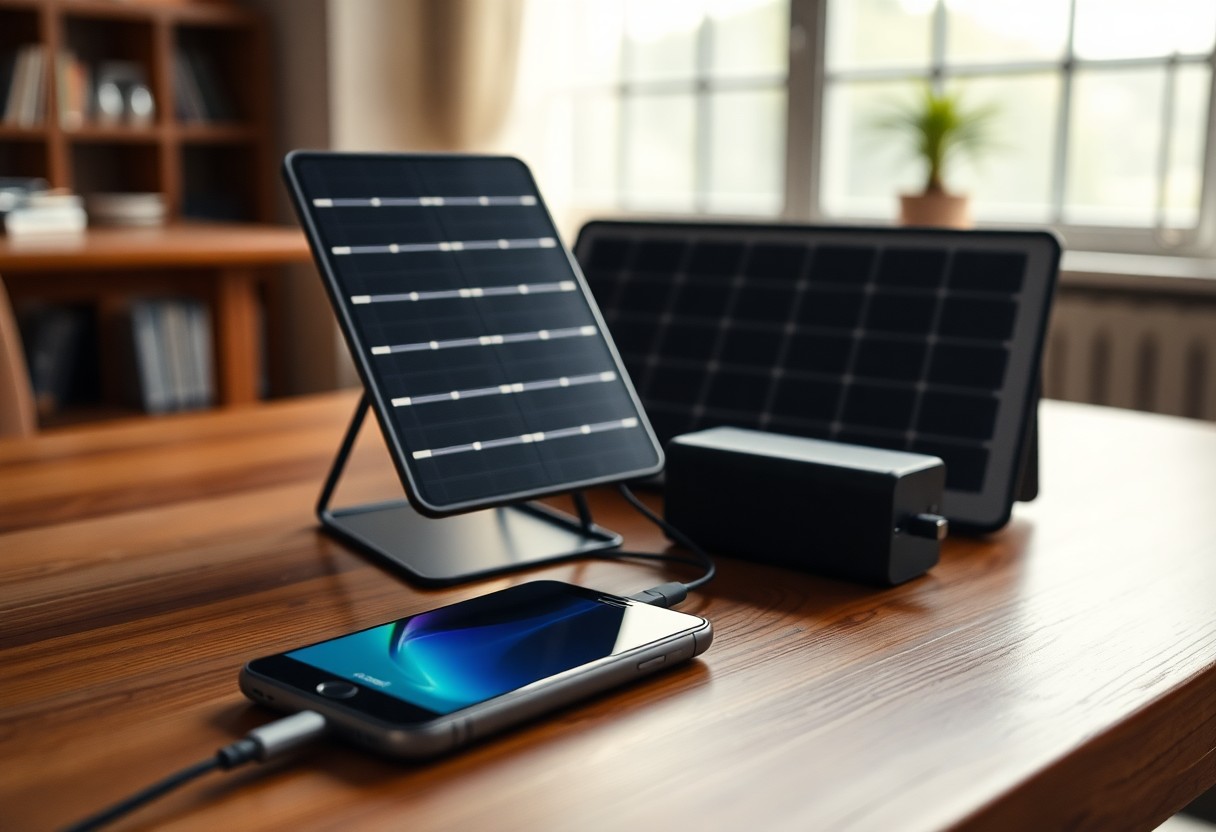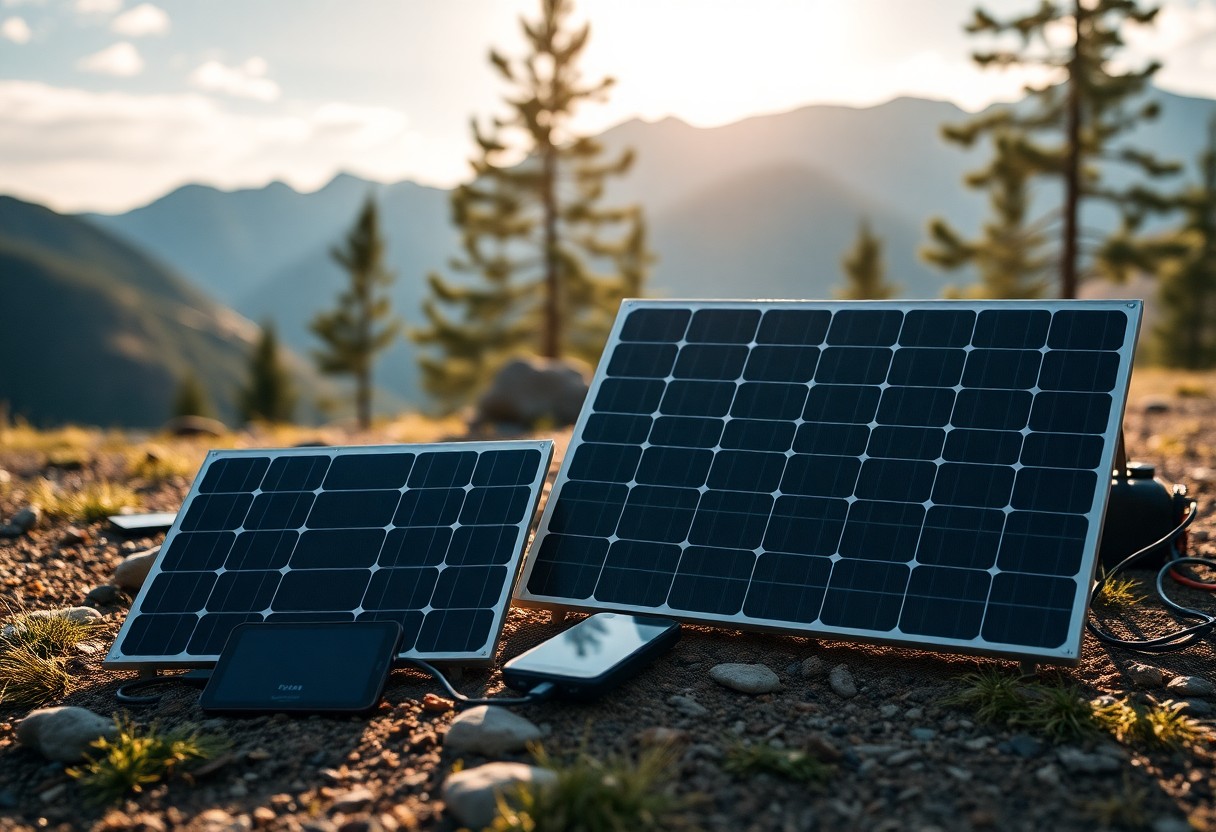Over the past few years, you may have found yourself in situations where access to conventional power sources is limited or non-existent. This raises the question of how to effectively keep your devices powered. In this post, you’ll explore the benefits and drawbacks of using solar chargers versus power banks for off-grid charging. By weighing the efficiency, cost-effectiveness, and convenience of each option, you can make an informed choice to suit your outdoor adventures or emergencies.
The Solar Revolution: Harnessing the Sun’s Power
With the increasing demand for sustainable energy solutions, the solar revolution is transforming the way you think about powering your devices. Innovative technologies now enable you to harness the sun’s abundant energy, providing a reliable and eco-friendly alternative to traditional charging methods. As you venture off-grid, solar solutions not only optimise your energy usage but also reduce your carbon footprint, allowing you to enjoy the great outdoors while remaining connected.
Components of a Solar Charging System
A solar charging system typically comprises a few crucial components: solar panels, a charge controller, a battery, and an inverter. Solar panels absorb sunlight and convert it into electricity, while the charge controller regulates the power flowing into the battery. The battery stores the energy collected, and the inverter transforms it into usable power for your devices. Together, these components create a harmonious system that ensures you always have energy when you need it.
The Efficiency of Solar Panels in Varied Environments
The performance of solar panels can vary significantly based on environmental factors including temperature, angle, and shading. While often rated under ideal conditions, real-world scenarios can impact their efficiency. For instance, solar panels typically perform best in sunny, unobstructed locations, but can still generate power in cloudy conditions, albeit at reduced capacities. A properly oriented panel can capture maximum sunlight, with efficiency dropping if positioned at shallow angles or obstructed by obstacles.
Understanding the efficiency of solar panels is key to maximising their output. In general, most modern panels offer around 15-20% efficiency under optimal conditions. Shaded areas can drop this efficiency significantly, sometimes to 50% or lower. Temperature plays a role as well; while panels generate more electricity in cooler conditions, excessive heat can lead to performance dips. Investing in high-efficiency panels and positioning them strategically in a sunlit location significantly enhances your off-grid charging capabilities, ensuring you get the most from your solar setup.
The Power Bank Paradigm: Convenience in Your Pocket
Power banks represent a compact solution for charging your devices on the go, making them an indispensable accessory for travellers and outdoor enthusiasts alike. These portable chargers provide a quick and efficient way to keep your gadgets powered without the need for a power outlet. Whether you’re hiking, camping, or simply out for the day, having a power bank in your pocket ensures that you won’t have to worry about your devices running out of juice unexpectedly. This reliance on portable power allows you to stay connected and capture memories without interruptions.
Types of Power Banks and Their Charging Capacities
Understanding the diverse range of power banks available can help you select the perfect model for your needs. Power banks vary in size and capacity, typically measured in milliamp hours (mAh). Here’s a quick overview to guide your choice:
| Type | Charging Capacity (mAh) |
| Mini Power Banks | 2,000 – 5,000 mAh |
| Standard Power Banks | 5,000 – 20,000 mAh |
| High-Capacity Power Banks | 20,000 – 50,000 mAh |
| Solar Power Banks | 8,000 – 25,000 mAh |
Pros and Cons of Relying on Power Banks
Advantages and Disadvantages of Power Banks
| Pros | Cons |
| Portable and lightweight design | Limited lifespan, typically 500-1000 cycles |
| Quick charging capability | Can require time to recharge |
| Compatible with most devices | Quality varies significantly between brands |
| Ideal for emergency situations | May not provide enough power for all devices |
Relying on power banks offers you remarkable convenience, especially when you’re away from traditional power sources. However, these benefits come at a cost. The limited lifespan of power banks means that their performance diminishes over time, and although the prices can be quite affordable, investing in higher-quality brands might be necessary to ensure reliability. Furthermore, while power banks can provide quick charging solutions, their recharging time can sometimes be a drawback, particularly when you’re in a hurry. You need to balance your need for power with the limitations that these devices present.

Comparing Energy Harvesting: Cost and Longevity
| Energy Source | Cost |
| Power Banks | Low initial investment; replacements needed every 1-2 years. |
| Solar Systems | Higher initial investment; returns over long-term savings on electricity. |
Initial Investment vs. Long-Term Savings
Power banks require a modest upfront cost, typically ranging from £20 to £100, but their longevity is limited, leading to repeat purchases. In contrast, investing in a solar energy system may appear steep at first, often between £500 and £5,000, yet it offers substantial long-term savings on your energy bills, paying for itself over time through reduced electricity costs.
Lifespan and Durability of Solar Systems vs. Power Banks
Solar systems generally boast a lifespan of 25 years or more, depending on the quality of the panels and maintenance. Power banks, however, tend to have a lifecycle of 500-1,000 charge cycles, translating to around 1-2 years of usability before they lose efficiency. The inherent durability of solar technology allows for consistent performance, while power banks may require frequent replacements and contribute to electronic waste.
Elaborating on the lifespan and durability factor reveals significant differences between these two energy solutions. A high-quality solar panel system can last upwards of 25 years, continually harnessing free solar energy for your devices without the need for costly replacements. In comparison, most power banks show signs of wear after just a couple of years of use, with reduced capacity and potential malfunction, necessitating further expenditure and contributing to environmental waste. Thus, while solar technology may involve a higher initial outlay, its longevity and eco-friendliness make it a more sustainable choice for long-term energy needs.
Suitability in Different Scenarios: When to Use What
Choosing between solar panels and power banks hinges on the specific circumstances of your adventure or need. If you’re heading out for a weekend camping trip, a power bank may suffice for short bursts of charging. However, for extended stays in remote locations, solar panels provide a sustainable solution, ensuring your devices remain powered over several days without the need for access to mains electricity.
Outdoor Adventures: Tailoring Your Solution
For outdoor excursions, a combination of both solutions can often provide the best result. A power bank can keep your phone charged during the day, while a portable solar panel charges it overnight. This method maximises your resources, allowing you to capture energy during daylight hours and store it for later use when you need it most.
Emergency Preparedness: Choosing the Right Device
Your choice of charging device plays a significant role in emergency preparedness. If you anticipate prolonged power outages, investing in a good-quality solar charger ensures you can recharge vital devices like emergency radios or mobile phones without reliance on a fluctuating power supply.
In emergencies, a reliable solar charger not only offers the benefit of endless power from sunlight but also keeps you connected to critical information. Solar chargers typically come equipped with multiple ports, allowing you to charge several devices simultaneously. For instance, a 20W solar panel can recharge a phone in about two to four hours, depending on conditions—much quicker than a traditional power bank might, especially when limited by capacity. Keep in mind the solar charger’s efficiency may fluctuate with weather conditions, making it important to have sufficient battery backup from a power bank to cover low-sun days. Being fully prepared means combining both to ensure you’re never left in the dark.
Environmental Impact: Sustainable Choices for the Future
Your decision to charge devices off-grid can significantly influence environmental sustainability. With the growing urgency of climate change, opting for renewable resources like solar energy not only reduces reliance on non-renewable sources but also encourages a greener lifestyle. As you consider energy options, understanding their long-term impacts will guide you in making informed choices that favour both technology and our planet.
Carbon Footprint of Solar Panels vs. Power Banks
The carbon footprint associated with solar panels is generally lower than that of power banks. While the manufacturing of solar panels involves emissions, over their lifespan, they can offset more than 25 times the CO2 produced during their creation. Power banks, on the other hand, often rely on lithium-ion batteries, contributing to greenhouse gas emissions throughout their lifecycle, from extraction to disposal.
Recycling and Disposal Considerations
With respect to recycling, solar panels can be repurposed, while power banks present more challenges due to their diverse components. Solar panels are typically constructed with materials that can be recycled, which reduces waste. Power banks, in contrast, require special facilities for lithium battery recycling to avoid environmental hazards. It’s crucial to check local regulations for proper disposal methods to prevent potential pollution.
Recycling practices for both options can significantly affect environmental outcomes. Solar panels can often be dismantled and their materials—like glass and metals—can be reused in new products, promoting a circular economy. However, power banks contain hazardous materials that can leach into soil and waterways if not disposed of correctly. In the UK, many councils offer battery recycling schemes, allowing you to return used power banks safely. By seeking out proper recycling channels, you ensure that you’re contributing to a more sustainable future while minimising your environmental impact.
Final Words
Taking this into account, choosing between solar chargers and power banks for off-grid charging largely depends on your specific needs and environmental conditions. Solar chargers offer a renewable energy source ideal for extended outdoor adventures, while power banks are convenient for short trips or emergencies requiring quick recharges. Assess your power requirements, intended usage scenarios, and how often you’ll have access to sunlight. By understanding your priorities, you can make an informed decision that ensures your devices remain charged and ready for use, wherever your adventures take you.
